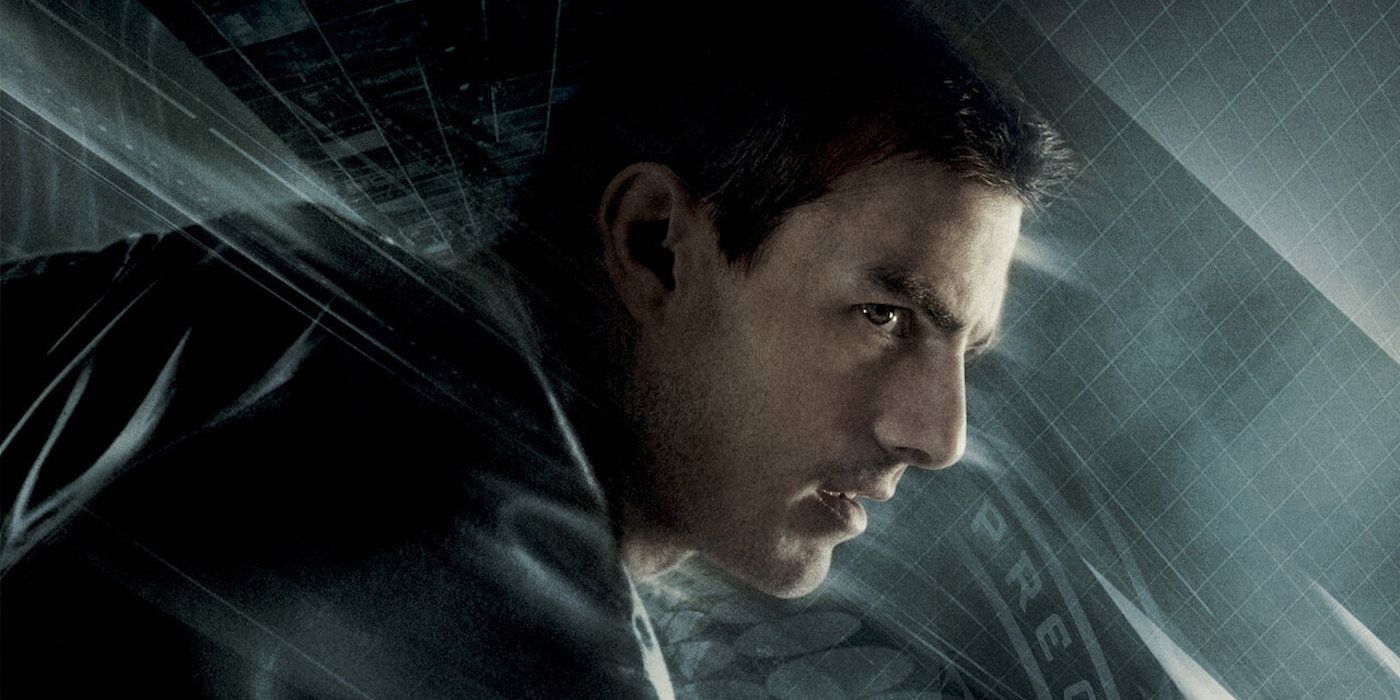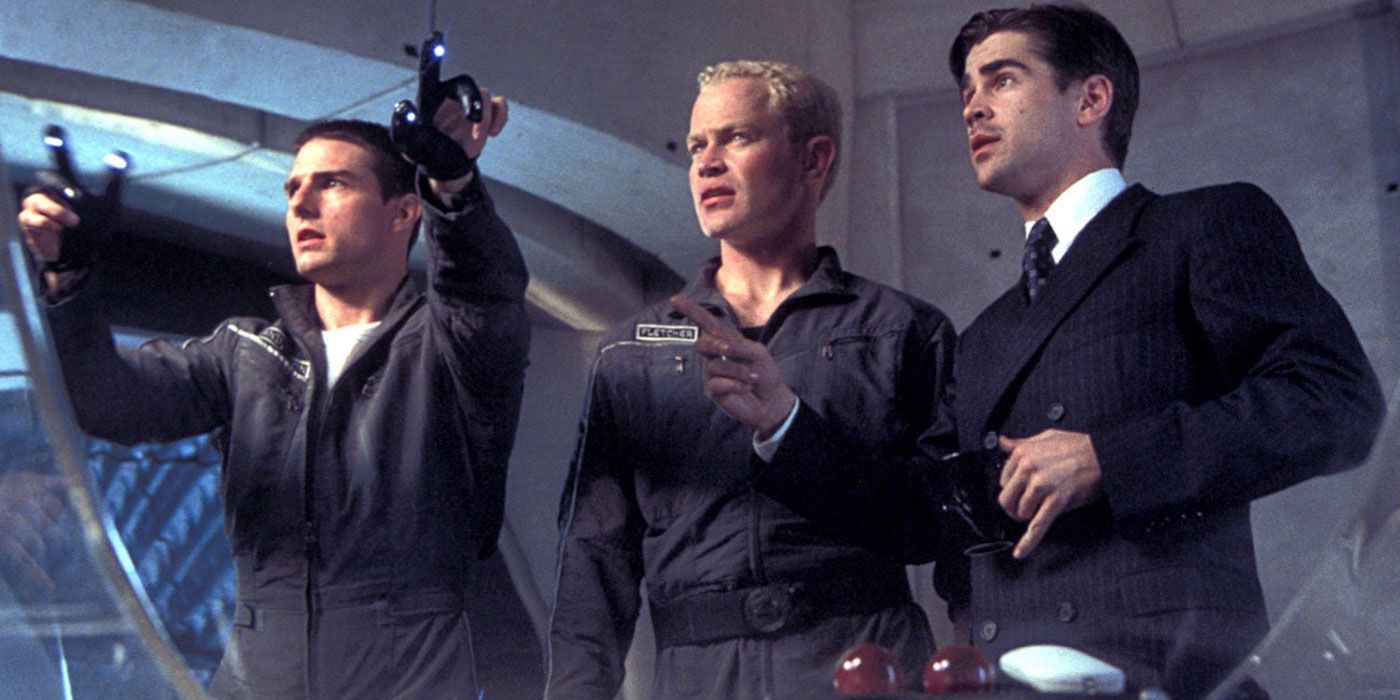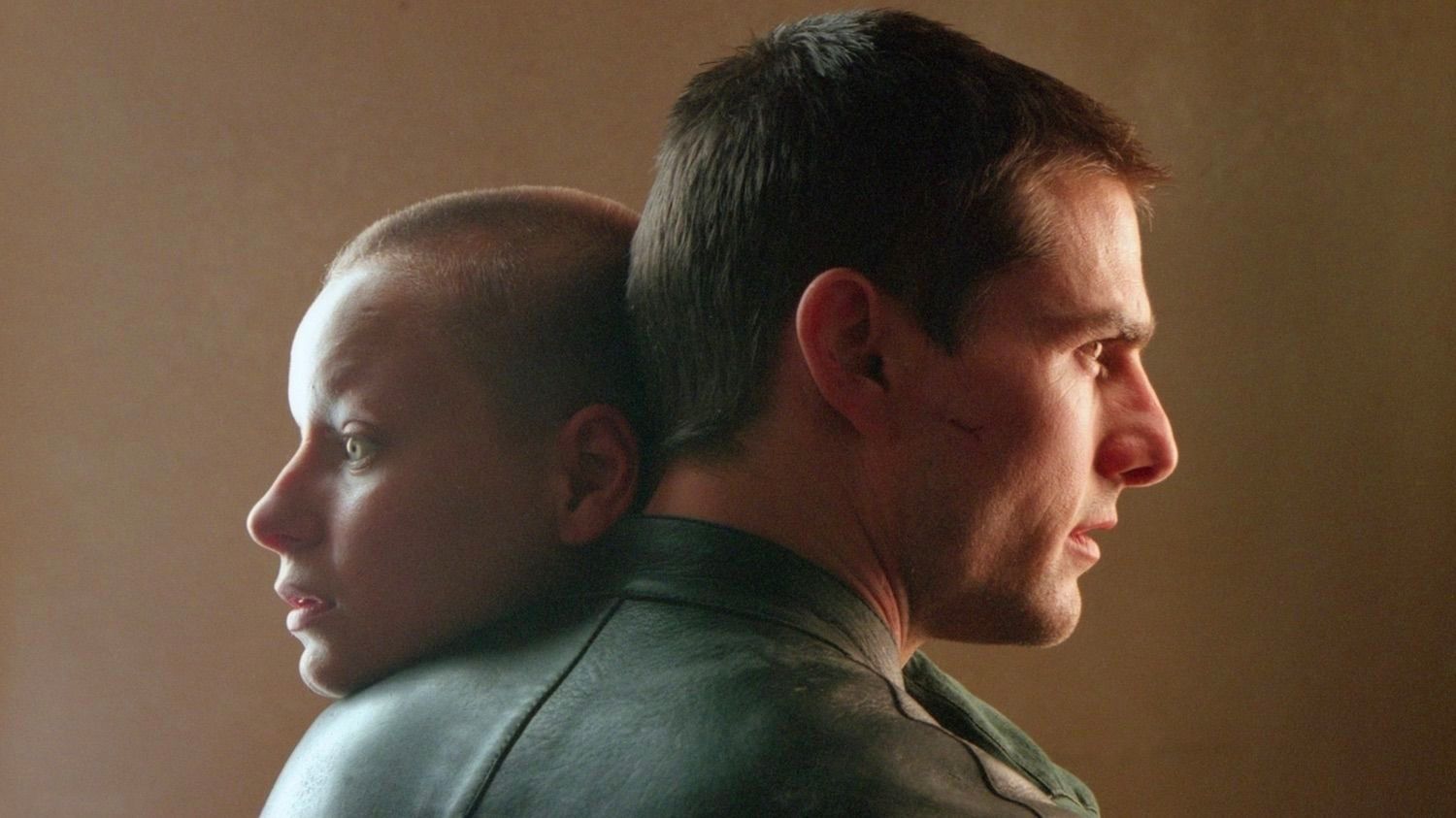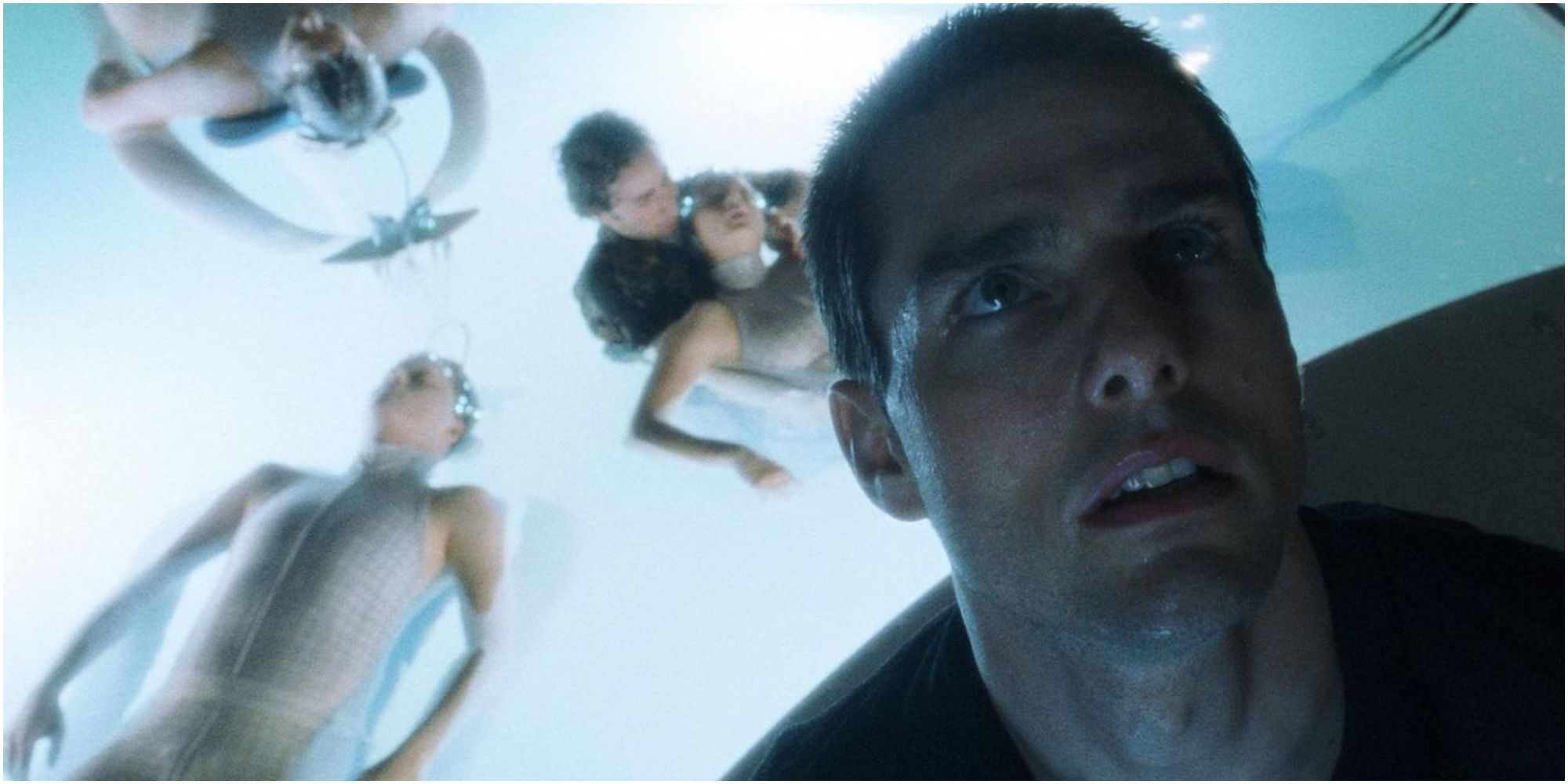Minority Report opens with a dreamlike montage that revolves around sight: a close-up of an eye, a pair of glasses, and scissors cutting eyeholes in an Abraham Lincoln mask. A woman is presently stabbed with the same scissors. We learn these images are a precognitive vision of a homicide, one that is prevented when John Anderton (Tom Cruise) storms the crime scene (significantly pushing the would-be killer’s hand through a window). From its opening moments it’s clear that Minority Report has the act of seeing very much in mind, although in this futuristic world being seen is equally important.
Minority Report is part of a sequence of science fiction films that Steven Spielberg made at the turn of the century, including A.I. Artificial Intelligence (2001) and War of the Worlds (2005). This was a return to the genre that had seen two of his biggest early career successes (Close Encounters of the Third Kind and E.T. the Extra-Terrestrial) and the chance to handle some weighty science fiction issues. A.I. Artificial Intelligence (a project that had been in development with the late Stanley Kubrick for years) deals with the moral implications of creating artificial life, while War of the Worlds updates H.G. Wells’ classic to imagine how a country-wide disaster might play out in modern-day America. Minority Report is arguably the most successful of the three films on a thematic level, predicting key issues in surveillance and data manipulation to come in the two decades following its release.
In the year 2054, law enforcement in Washington D.C. uses “precogs,” individuals with the ability to see the future, to prevent murders. Chief John Anderton oversees the city’s Precrime Program, which analyses data from the precogs and makes arrests with the evidence. When a precog vision shows him shooting a stranger, Anderton goes on the run, chased by his former colleagues and an ambitious investigator from the Department of Justice, Danny Witwer (Colin Farrell). In trying to clear his name, Anderton discovers that the visions of the precogs are not as infallible as the Director of Precrime (Max von Sydow) would like the world to believe.
For a Spielberg film (which is typified by style in service of story, rather than the style as story of contemporaries such as Brian de Palma), Minority Report is unusual in its obsessive focus on a single motif. In addition to the many images of eyes (both seeing and sightless) in the precog visions, we get plot devices involving eyeball implants and replacements, a red herring about a man staring in a window, and Anderton’s compulsive viewing of old home movies. He's addicted to a designer drug called Clarity, sold to him by a dealer with gaping eye sockets. In one scene (a welcome hit of Spielbergian comedy), Anderton even chases his removed eyeballs down a ramp, catching one by the severed optic nerve before it falls through a grate.
The acute focus on sight in relation to crime recalls Alfred Hitchcock’s best films, such as Rear Window and Vertigo, in which investigative work is framed in terms of compulsive or voyeuristic intent. There’s certainly something of the Hitchcock hero to Anderton, whose seeing is compromised by his own drives and guilt. Spielberg also gives a nod to the master of suspense in a factory-set action scene where Anderton emerges from a freshly constructed car and drives away. It was an idea that Hitchcock had wanted to use for his man-on-the-run classic North by Northwest, although in his version it was a corpse that would appear in a newly made vehicle.
Yet Spielberg intends more than a futuristic take on a Hitchcock pursuit thriller. The antagonistic Witwer is introduced to question Anderton’s belief in Precrime, and to raise the obvious issues of free will and determinism posed by the process. It’s in one of their discussions about the religious connotations of the precogs and their handlers that a key theme is elucidated. On learning that the chamber in which the precogs are kept is called “the temple," Witwer dismisses the idea they are gods by stating, “the oracle doesn’t have the power… it lies with the priests.” Indeed, the precogs are used as data-gathering tools and the way in which that information is manipulated is a central concern of the film.
While behavioral data is collected on citizens through the precog visions, Anderton’s situation (in which he sees the data, goes on the run, and meets his intended victim as a result) raises whether the act of collection changes the behavior of the subject. It’s a classic sci-fi paradox that was posed in the 1956 Philip K. Dick novella on which the film was based. However, Minority Report was released shortly before the first iteration of Facebook. Within 15 years, Cambridge Analytica was harvesting its data to build trait profiles of 70 million Americans that would be used with the aim of changing voter behavior. Real-life had caught up with the philosophical question of free will very quickly. In 2018, when the Cambridge Analytica scandal broke, it appeared that the power really did reside with the contemporary data priests.
Minority Report was also prescient about the way data is collected and under what conditions. While the precogs are a sci-fi gambit straight out of Dick’s oeuvre (full of characters with extra-sensory abilities that create paradoxical situations), the film’s other technology is more believable. Washington in 2054 is divided into two distinct areas, a sleekly beautiful city of maglevs and malls above, and an undeveloped slum known as “the Sprawl” below. In both areas, citizens have been fitted with ocular implants that can be scanned for personal data, whether by security cameras or spider-like robots. It’s clearly a surveillance state, and cinematographer Janusz Kamiński reinforces this by capturing the city scenes with a color-drained palette, recalling the whites and grays of CCTV footage. But the filmmakers are smart in their anticipation that this has not come as the result of a dystopian overthrow of the government. Rather, we see citizens benefiting from the implants as they receive tailored recommendations in the shopping mall, pass through security checks, and board the subway without the need for a physical ticket.
In this manner, the film anticipates our current relationship with data and technology. Every time we download a free app or agree to the terms and conditions on social media, there’s the potential exchange of information about ourselves in return for a product. When we install internet-linked security cameras around our homes or accept cookies that track our movements, we’re sacrificing a measure of privacy in return for utility. Minority Report even shows Anderton’s automated apartment, which turns on lights and starts a chosen playlist when he comes home, prefiguring the internet of things.
As we know, this quid pro quo is fraught with problems, which the film also anticipates. The targeted advertisements in the mall become a source of anxiety for the fugitive Anderton as his eyes are pinged by every store and billboard camera. In one brilliant piece of futurism, a man on the subway reads a tablet-like newspaper displaying a picture of Anderton’s face and the headline, “Precrime Hunts its Own.” This occurs just moments after Anderton has gone on the run, foreseeing a world in which surveillance and media combine to create an almost instantaneous news cycle. Anderton’s only option is to have his eyeballs removed and replaced, suggesting that in the future disconnection from the information grid will be painfully difficult.
Then again, Anderton is a bad person – a fugitive because the state has predicted that he will commit a crime. People who have nothing to hide have nothing to fear from technology that only makes their lives better and safer. Of course, Minority Report doesn’t side with such a view (Anderton’s journey is about discovering the flaws in the system), but it’s one that is commonly expressed in support of increased surveillance. In 2001, the City of London had over a million CCTV cameras. By 2005, it had four times as many, almost one camera for every person who lived in the city. At the time of Minority Report's release, surveillance infrastructure was exploding in the real world.
With this in mind, the film's Washington setting seems especially important, representing the seat of both government and the judicial system. In early scenes, we see Anderton video-conferencing a pair of judges during a Precrime investigation and using them to make determinations on the case. At the alleged crime scene, Precrime officers simultaneously make an arrest and deliver a sentence, fitting the perpetrator with a collar that puts them in suspended animation. In support of increased safety (we are told the murder rate has dropped to zero in Washington under Precrime) due process in the legal system has been subverted. Anderton’s discovery of the flawed prosecution of thousands of people points to the dangers of putting technology above human rights. In the film’s coda, Anderton states that the people convicted under Precrime were unconditionally pardoned and released, qualifying this by adding, “although police departments kept watch on many of them for years to come.” The outcome is clear: even with evidence of abuse, the mechanism of the surveillance state will continue.
Of any mainstream director from his generation, Spielberg’s films most often concern children, either directly or through the lens of their adult characters. His run of sci-fi films from this period is significant for their focus here. A.I. Artificial Intelligence is a retelling of Pinocchio in its story of a child robot seeking love and family. War of the Worlds concerns an immature man (also played by Cruise) who bonds with and takes responsibility for his children through disaster. In Minority Report, Anderton is driven to support Precrime after the abduction of his son (importantly in a moment when he let him out of his sight). However, his urge to protect has become unhealthy, both through his arrested emotional state and his blind support for a technology that is harmful to civil liberty. His ultimate rejection of Precrime is the rejection of a system that infantilizes the individual, taking away choice and creating a state of constant watchfulness in the name of protection. Twenty years later, when so much of what it depicted has come to pass, Minority Report looks less like entertainment and more like a warning.





